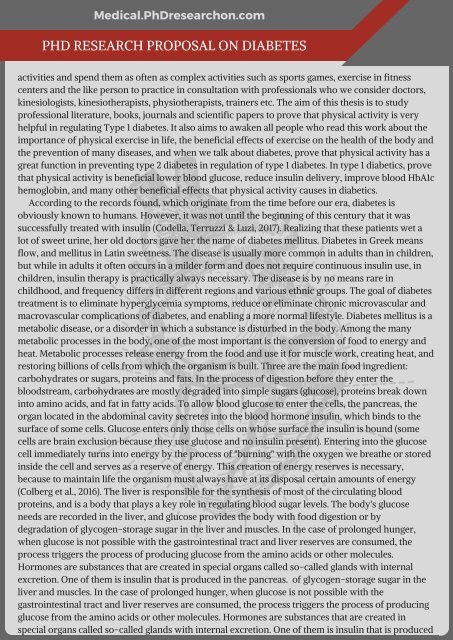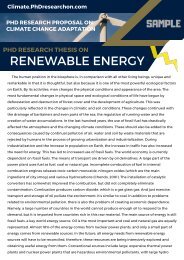Diabetes PhD Research Proposal Sample
Hello, here is a new sample of a diabetes PhD research proposal, learn more http://medical.phdresearchon.com/
Hello, here is a new sample of a diabetes PhD research proposal, learn more http://medical.phdresearchon.com/
You also want an ePaper? Increase the reach of your titles
YUMPU automatically turns print PDFs into web optimized ePapers that Google loves.
Medical.<strong>PhD</strong>researchon.com<br />
PHD RESEARCH PROPOSAL ON DIABETES<br />
activities and spend them as often as complex activities such as sports games, exercise in fitness<br />
centers and the like person to practice in consultation with professionals who we consider doctors,<br />
kinesiologists, kinesiotherapists, physiotherapists, trainers etc. The aim of this thesis is to study<br />
professional literature, books, journals and scientific papers to prove that physical activity is very<br />
helpful in regulating Type 1 diabetes. It also aims to awaken all people who read this work about the<br />
importance of physical exercise in life, the beneficial effects of exercise on the health of the body and<br />
the prevention of many diseases, and when we talk about diabetes, prove that physical activity has a<br />
great function in preventing type 2 diabetes in regulation of type 1 diabetes. In type 1 diabetics, prove<br />
that physical activity is beneficial lower blood glucose, reduce insulin delivery, improve blood HbA1c<br />
hemoglobin, and many other beneficial effects that physical activity causes in diabetics.<br />
According to the records found, which originate from the time before our era, diabetes is<br />
obviously known to humans. However, it was not until the beginning of this century that it was<br />
successfully treated with insulin (Codella, Terruzzi & Luzi, 2017). Realizing that these patients wet a<br />
lot of sweet urine, her old doctors gave her the name of diabetes mellitus. <strong>Diabetes</strong> in Greek means<br />
flow, and mellitus in Latin sweetness. The disease is usually more common in adults than in children,<br />
but while in adults it often occurs in a milder form and does not require continuous insulin use, in<br />
children, insulin therapy is practically always necessary. The disease is by no means rare in<br />
childhood, and frequency differs in different regions and various ethnic groups. The goal of diabetes<br />
treatment is to eliminate hyperglycemia symptoms, reduce or eliminate chronic microvascular and<br />
macrovascular complications of diabetes, and enabling a more normal lifestyle. <strong>Diabetes</strong> mellitus is a<br />
metabolic disease, or a disorder in which a substance is disturbed in the body. Among the many<br />
metabolic processes in the body, one of the most important is the conversion of food to energy and<br />
heat. Metabolic processes release energy from the food and use it for muscle work, creating heat, and<br />
restoring billions of cells from which the organism is built. Three are the main food ingredient:<br />
carbohydrates or sugars, proteins and fats. In the process of digestion before they enter the<br />
bloodstream, carbohydrates are mostly degraded into simple sugars (glucose), proteins break down<br />
into amino acids, and fat in fatty acids. To allow blood glucose to enter the cells, the pancreas, the<br />
organ located in the abdominal cavity secretes into the blood hormone insulin, which binds to the<br />
surface of some cells. Glucose enters only those cells on whose surface the insulin is bound (some<br />
cells are brain exclusion because they use glucose and no insulin present). Entering into the glucose<br />
cell immediately turns into energy by the process of "burning" with the oxygen we breathe or stored<br />
inside the cell and serves as a reserve of energy. This creation of energy reserves is necessary,<br />
because to maintain life the organism must always have at its disposal certain amounts of energy<br />
(Colberg et al., 2016). The liver is responsible for the synthesis of most of the circulating blood<br />
proteins, and is a body that plays a key role in regulating blood sugar levels. The body's glucose<br />
needs are recorded in the liver, and glucose provides the body with food digestion or by<br />
degradation of glycogen-storage sugar in the liver and muscles. In the case of prolonged hunger,<br />
when glucose is not possible with the gastrointestinal tract and liver reserves are consumed, the<br />
process triggers the process of producing glucose from the amino acids or other molecules.<br />
Hormones are substances that are created in special organs called so-called glands with internal<br />
excretion. One of them is insulin that is produced in the pancreas. of glycogen-storage sugar in the<br />
liver and muscles. In the case of prolonged hunger, when glucose is not possible with the<br />
gastrointestinal tract and liver reserves are consumed, the process triggers the process of producing<br />
glucose from the amino acids or other molecules. Hormones are substances that are created in<br />
special organs called so-called glands with internal excretion. One of them is insulin that is produced





